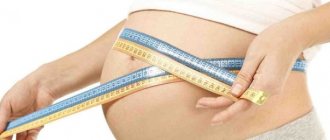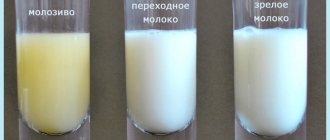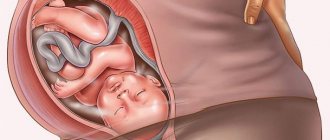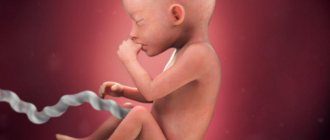From the moment the egg is fertilized and implanted in the uterine cavity, hormonal changes begin in the woman’s body, which will contribute to the preservation of pregnancy and its successful development. Previously released hormones change their concentration (progesterone and estrogen are produced more actively), which is expressed in different manifestations. The breasts are one of the first to react to hormonal changes. Very often, it is the nipples that prompt a woman to think about the possibility of conception.
The breast begins to react to pregnancy from 10-14 days after conception, that is, virtually immediately after implantation of the egg. Moreover, both the breasts in general and the nipples in particular change. And this process lasts throughout the entire period of bearing the baby.
How nipples change during pregnancy:
- increased nipple sensitivity during pregnancy
One of the most important is increasing the sensitivity of the nipples. This feeling begins to simply irritate the woman: any touch to the nipple causes not only discomfort, but also infuriates her. Meanwhile, many women’s nipples become hypersensitive before each period, so often at this stage they still have no idea about anything, regarding this symptom as a manifestation of premenstrual syndrome.
But when you are already aware that you are pregnant, and your nipples hurt when pressed or touched, then it is better to immediately change your bra to the simplest and most comfortable one. The cup should be perfectly even and smooth - without seams or decorative elements that irritate the nipples. Some doctors recommend placing pieces of coarse fabric in the cups, which will prepare the breasts for future feeding, and at the same time reduce their sensitivity and soreness.
Air baths will also have a beneficial effect on the chest and reduce soreness. Yes, and my husband will be pleased, to say the least. By the way, it’s not for nothing that nipples become hypersensitive: this is how they protect the breasts from now unnecessary stimulation, which can lead to the release of the hormone oxytocin, which causes uterine contractions.
- swelling of the nipples during pregnancy
Throughout pregnancy, the breasts noticeably increase in size and become 2-3 times heavier. Naturally, the nipples swell along with it. All this happens due to the activity of hormones. The nipple enlarges, becomes more elongated and prominent. Many women are upset by such changes, but men really like it.
- darkening of the nipples during pregnancy
That's when you can really suspect that you are pregnant, this is when pigmentation begins to intensify. The first signs of pregnancy include darkening of the nipples and areolas. This does not happen to all women, but often the nipples become noticeably darker and even change color completely.
By the way, similar changes may affect. But nipples are, of course, easier to notice.
- Montgomery tubercles during pregnancy
Often, from the first weeks of pregnancy, a woman notices the appearance of small pimples around her nipples. These are the Montgomery tubercles, which are more correctly called glands. They are present in the nipple areolas of every woman, but become especially noticeable during pregnancy and breastfeeding.
The number of Montgomery glands can be very different - from a few pieces to multiple points around the nipple. But most often during pregnancy there are about 12 of them on each nipple. It is believed that the more tubercles, the more milk a woman will have.
Montgomery's tubercles are vestigial glands. It is not at all necessary that they manifest themselves during pregnancy, although it happens that they appear from the first days. In most cases, these glands hide after breastfeeding stops, although they often remain on the nipples. Don't worry about this - there's nothing wrong with it.
- release of colostrum during pregnancy
Already from the second trimester, a pregnant woman may notice the release of colostrum from the nipples (clear, whitish or yellowish liquid), although most often this occurs closer to childbirth, in the third trimester. Hormones are again to blame for this, as they prepare the breasts for early feeding.
If you notice droplets on your nipples, then under no circumstances squeeze it out of your breast. Just pat dry thoroughly and be sure to maintain good hygiene by showering twice a day. If the need arises, you can use chest pads. By the way, it is very useful to lubricate the nipples with a drop of colostrum - this prevents them from drying out and prevents the formation of cracks during feeding.
At what stage of pregnancy do the areolas darken?
– During pregnancy – At what stage of pregnancy do the areolas darken
? Why does the areola around the nipple darken? Can a similar effect occur not due to pregnancy?
When do nipples start to swell?
In most cases, nipples become swollen in the first weeks after conception has occurred. This is one of the sure signs that pregnancy has taken place and hormonal changes have begun. An increase in the amount of pregnancy hormone, under the influence of which the nipples swell and change their shape, becoming more convex.
Breast discharge during pregnancy
Around the beginning of the third trimester, discharge from the breast appears. This colostrum is the first milk. Whitish or yellowish in color. It is released in small quantities even if it is specially squeezed out of the nipple. Colostrum begins to be released under the influence of oxytocin, a hormone whose level gradually increases shortly before birth.
Breast enlargement during pregnancy
Almost immediately after conception, the breasts fill out and increase in size. During the entire pregnancy, or rather during the first 10 weeks of bearing a baby, it increases almost 3 times. This is how the female body prepares for lactation.
Montgomery tubercles during pregnancy
These are small tubercles that are located near the nipple on the areola. During pregnancy, they become more clearly visible, and in some women they increase slightly. Near each nipple there are at least 6, no more than 12 pieces.
These tubercles begin to develop during puberty. When they become clearly visible, the breasts are ready for feeding. Scientists still do not know the exact purpose of these tubercles.
It is believed that they secrete a specific secretion and are directly involved in lactation. The smell of this secretion attracts the baby and thus he finds the breast. This lubricant protects the skin in and around the nipple from drying out and infection.
Doctors have established a direct connection between the number of Montgomery tubercles and the amount of milk - the more tubercles, the better lactation.
Breast pain during pregnancy
When breasts enlarge during pregnancy, they become more sensitive. Some women, in addition to heaviness, also feel pain. Usually the pain is not severe, about the same as during menstruation. This is a normal occurrence during pregnancy, although quite uncomfortable for some.
Darkening of areolas during pregnancy
Starting from the 4th week of gestation, the nipple and the skin around it acquire a darker shade. The color of the areola during pregnancy depends on the nationality and hair color of the mother. The darker the hair, the darker the areola will be. In fair-haired and pale-skinned women, the areola may be red.
For dark-haired people it’s chocolate or even black, or rather so dark brown that it seems black. The skin around the nipple darkens due to the increased content of the hormone melamine. During this same period, pigment spots may appear. By the way, the areola does not remain dark for long; before giving birth it becomes significantly lighter.
The previous color will be established after the baby is born.
Can nipple areolas darken not due to pregnancy?
The areola does not always darken because a woman is pregnant. Sometimes the same effect is observed with:
- Acute deficiency of vitamins B and D, folic acid.
- Hormonal disorders.
- Endometriosis.
- Uterine fibroids.
- Constant stress.
- Polycystic ovary syndrome.
Darkening of the nipples can also cause uncomfortable underwear. Therefore, you should choose a bra that is sized and has a design that is more comfortable to wear.
When should you see a doctor?
If a woman’s nipples darken every month, without additional symptoms, then perhaps this is her anatomical feature. Particular attention should be paid if the darkening of the areolas occurred unexpectedly, for no apparent reason.
You should consult a doctor immediately if the darkening is accompanied by chest discomfort or distinct pain. During pregnancy, the darkening of the areolas occurs naturally and does not indicate a violation, rather, on the contrary, that the gestation process is proceeding correctly.
If this is not related to pregnancy and is not a common occurrence for a woman, then you should consult a doctor and find out what caused the darkening. Survey
Source: https://zen.yandex.ru/media/id/5cc401b4c6b7e700b3d82c58/5cd05c37583aa800af53bb24
Nipple stimulation during pregnancy
And the last thing that cannot be ignored is nipple stimulation during pregnancy. Be extremely careful with this. Men really like the rounded shapes of their pregnant beloved wives. It’s simply a sin to leave such breasts unattended, but this may turn out to be unsafe. Stimulation of the nipples during pregnancy tones the uterus, which can provoke the threat of miscarriage or. During or in later stages, such a natural one may even be useful. But while the time for childbirth has not yet come, it is better not to take risks and not touch the nipples again.
It should be said that the described changes in the breasts and nipples will not necessarily manifest themselves. In some women, the breasts do not change at all until the birth itself, and only during the arrival of milk they begin to swell and harden. Do not worry if breast changes did not affect you during pregnancy - this is also normal. Each woman is individual, and her pregnancy proceeds differently from another.
Especially for
— Elena Kichak
Pregnancy leaves its mark on a woman’s entire body. The breast is usually the first to react to such changes.
Literally from the early weeks of pregnancy, it can begin to swell and fill up. Subsequently, the breast changes its shape, in most cases greatly increasing in size.
The nipples do not lag behind the mammary glands, becoming larger and more sensitive, and also changing in color. The space around the nipple - the areola - also increases in size (from the usual 5 cm in diameter to 8 or more).
Changes in the breasts during pregnancy
Breast engorgement. Over the entire gestational period, the mammary glands may increase in volume by 2-3 sizes.
Darkening of the nipples and areolas. Hyperpigmentation of the skin and mucous membranes, which is characteristic of the gestational age, also manifests itself in the form of darkening of the nipples and areolas.
Sensitivity and enlargement of the nipples. Even inverted and flat nipples during pregnancy, under the influence of hormones, increase in size and become more convex, and often become very sensitive to any touch.
Montgomery's nodules. These are small bumps around the nipples, which are vestigial glands and appear exclusively during pregnancy.
Colostrum release. This sign is most typical for late gestation and is not mandatory.
Darkening of the nipples during pregnancy
Normally, nipples are pale pink in color. During pregnancy, you may notice that these areas of the body are much darker than usual. This process affects not only the nipple, but also the areola.
In dark-skinned women, pigmentation appears in a rich brown, almost black color. Pregnant women with light hair and skin during pregnancy become the owners of reddish nipples.
When do areolas darken during pregnancy and what is associated with this process?
When does nipple darkening occur?
Noticeable changes in nipple color begin to appear as early as 5-6 weeks after conception.
By the way!
Such pigmentation may directly indicate the presence of pregnancy, if you have not previously identified it.
Why is this happening?
During childbirth preparation courses, we often discuss with mothers the question of why nipples darken during pregnancy?
There are several reasons for these changes:
- The influence of hormones;
The process of nipple pigmentation is directly related to the active restructuring of the body during pregnancy.
During pregnancy, your production of melanin, the hormone responsible for the color of your hair, eyes and skin, increases. During pregnancy, first of all, it begins to accumulate in the nipples.
- Lack of nutrients in the body;
A lack of necessary microelements (folic acid) or vitamins (group B) also often provokes darkening of the nipples and areola during pregnancy.
- Hereditary factor.
A change in the color of nipples in expectant mothers in a woman’s family will most often affect her during pregnancy.
In most cases, excess pigmentation is the result of a combination of all of these factors.
Do areolas always darken during pregnancy?
No, some pregnant women do not notice any color changes in this area of the body. In addition, some pregnant women experience no changes at all in the breast area - neither in size nor in shape.
However, most expectant mothers still notice engorged and enlarged breasts, as well as very darkened nipples and areolas.
Does anything need to be done about this?
Darkening of the nipples during pregnancy is not at all a cosmetic defect. If increased pigmentation is not accompanied by any alarming signs, there is no need to worry about it.
The situation is different if the darkening is accompanied by additional signs:
- different color and size of nipples;
- the appearance of black dots or tubercles on the areola;
- bloody or purulent discharge from the ducts;
- bluish or purple tint to the nipples and areola;
- the presence of lumps, nodules or other growths;
- darkening of the nipple is accompanied by high fever or chest pain (read the article
Very often, pregnancy is signaled by changes in the mammary glands. Often, the breasts react to conception from the very first days, and from the changes that occur, a woman can understand that she will soon become a mother.
Not only the breasts change, but also the nipples during pregnancy. Many women are interested in whether nipples can hurt during pregnancy and why nipples hurt during pregnancy. Changes in the mammary glands and nipples while expecting a baby are caused by a number of reasons, which we will consider in this article.
Reasons for changes
After fertilization of the egg, the female body undergoes hormonal changes that contribute to the preservation and successful development of pregnancy. The concentration of previously released hormones changes, estrogen and progesterone begin to be produced more actively, which affects the mammary glands and causes changes in the nipples during pregnancy. It is these changes that often become the first signal of conception.
As a result of the effects of prolactin, pregnant women's nipples become larger and more sensitive. The mammary glands change throughout pregnancy, preparing for lactation.
Signs of pregnancy
While carrying a child, a woman’s body changes greatly and is restructured under the influence of hormones. Even before purchasing a pharmacy test, you can notice the first signs of pregnancy. The nipples and breast size undergo changes first.
In order to understand when the first hormonal fluctuations affecting the mammary glands begin, it is necessary to consider what happens after conception. With successful fertilization, the egg attaches to the wall of the uterus, and the hormones responsible for the further successful development of pregnancy - estrogen, progesterone and prolactin - begin to be produced. It is these hormones that trigger a cascade of complex reactions in the body aimed at successful pregnancy. How the appearance changes:
That is, even before your period is missed, you can suspect pregnancy; you just need to take a close look at your body and know what changes may occur in it.
Nipple changes
Many women are interested in when and how nipples change during pregnancy. Also for many, the relevant question is when areolas begin to darken and whether nipples hurt during pregnancy. For some women, the changes are painless, while others experience discomfort and pain.
Increased sensitivity
One of the first changes after conception is increased sensitivity of the nipples. Many women are familiar with this feeling, since a similar phenomenon occurs before menstruation, so hypersensitivity is often perceived as a sign of premenstrual syndrome. Sensitivity of the nipples during pregnancy causes discomfort; any touch brings discomfort and causes irritation.
Darkening
Also in the early stages, darkening of the nipples and areola is observed. This is also caused by hormonal changes, as nipples darken during pregnancy under the influence of melatonin. The labia also darken, a vertical line on the abdomen darkens, and pigment spots appear on the skin, especially on the face.
It is believed that other factors such as:
- stress;
- lack of folic acid;
- deficiency of B vitamins.
It has been noticed that in dark-haired women the manifestations of pigmentation are more intense than in fair-haired and fair-skinned women.
Swelling
While carrying a child, the mammary glands enlarge, the nipples also become larger and change their shape to a more elongated one. Often, nipple pain during pregnancy is caused by their growth.
Montgomery tubercles
Often in the first trimester, a woman notices the appearance of small pimples on the areola. These are the Montgomery tubercles, rudimentary glands that become especially noticeable during pregnancy and lactation. Their number varies from a few pieces to a scattering of pimples throughout the areola. Some believe that if the nipples have a large number of Montgomery tubercles during pregnancy, then the nursing mother will have enough milk. After breastfeeding ends, the glands may disappear, but they may remain, which does not pose any threat.
If the glands are inflamed and there is redness of the areola, under no circumstances should you squeeze out the contents of the glands or apply any compresses. A timely visit to a mammologist will help solve this problem.
Colostrum release
From the second trimester, whitish, transparent or yellowish discharge (colostrum) may be observed, but more often colostrum begins to be released closer to childbirth, in the third trimester. Colostrum precedes breast milk production and is normal.
If there is discharge from only one nipple, the colostrum has serous bloody spots, and the nipple hurts during pregnancy, you should immediately consult a mammologist.
Our grandmothers also lubricated the nipples with secreted colostrum, this prevented drying of the skin and served as a good prevention of cracks during breastfeeding.
Areola changes
Some women experience an increase in the areola, its boundaries become less pronounced and blurred. In others, the contour of the areola, on the contrary, becomes brighter and more clearly defined. Closer to childbirth, the nipple and areola become brighter in color. The areola and nipples in pregnant women change most dramatically in the first half of the first trimester and in the second half of the third.
Itching
Rapid breast growth, skin stretching and dry nipples during pregnancy often cause peeling skin and itching.
Nature and causes of pain
Many expectant mothers note that their nipples hurt especially badly in the early stages during the period of active growth. Gradually, the sensitivity of the nipples decreases; closer to childbirth, they become rougher and stop reacting sharply to irritants.
Unpleasant and painful sensations can be of various types, often accompanied by burning and itching. If the sensitivity of the nipples has increased, then they begin to react to any touch, become thicker and hurt.
Also, due to changes in shape and size, cracks or erosions, swelling and redness may appear. Discharge from the nipples leads to irritation, itching and crusting.
Sometimes pregnant women develop mastitis. This occurs due to bacteria entering the milk ducts through cracks. In this case, in addition to pain, severe redness, swelling and fever are observed.
Prevention and symptom relief
With visible changes in the mammary glands, not all women experience pain. It is impossible to say unequivocally what nipples should be like during pregnancy, because everyone’s sensations are different and largely depend on the pain threshold.
To avoid negative consequences, it is necessary to properly care for your breasts and nipples from the first days of pregnancy:
- It is better to take a hygienic shower without using soap or shower gel, as they can cause dry skin.
- Wet contrast rubdowns and air baths reduce pain.
- Particular attention should be paid to underwear. You should give preference to quality products made from natural fabrics. Special maternity bras hold the breasts well without deforming or compressing them.
- Breast pads are essential when releasing colostrum. They must be changed regularly to avoid bacterial growth.
- Rough fabric inserted into the bra cups will help prepare the breasts for feeding and reduce their sensitivity and soreness.
- Special exercises for the breasts will help strengthen the muscles and maintain shape after feeding.
Alarming symptoms
As we discussed above, if your nipples grow, darken and hurt, this is a sign of pregnancy. This is one of the symptoms of the normal process of preparing the breast for feeding a baby.
But it happens that pain signals some kind of disease.
A consultation with a mammologist is required if, in addition to nipple pain, the following symptoms are added:
- swelling and severe itching;
- a sharp increase in pain, a change in its character;
- cracks or sores on the nipple and areola;
- serous or bloody discharge;
- severe heaviness and swelling of the breasts;
- bumps and swelling around the areola;
- if the nipples suddenly turn white, especially with excitement or hypothermia.
It is necessary to visit a doctor if the following are added to these manifestations:
- deterioration of health;
- a sharp increase in temperature;
- heaviness in the head or frequent headaches;
- mood swings, increased nervousness;
- feeling tired and drowsy.
It is also worth seeking advice from a mammologist if there are papillomas on the nipples, especially if they get into the baby’s mouth during feeding. In this case, they will need to be removed before birth.
You should not diagnose yourself and self-medicate.
What symptoms should you be wary of?
You should consult a doctor if the following symptoms appear:
- severe pain in the mammary gland;
- depressions or lumps are felt in the chest;
- discharge appears from one nipple;
- the discharge takes on an unnatural color (brown, green) and has an unpleasant odor;
- blood comes out of the nipples;
- Only one mammary gland grows.
There is no need to wait for a scheduled examination by a gynecologist; these conditions require urgent examination. They may indicate an inflammatory process in the breast or neoplasms. Remember that any normal changes in the mammary glands during pregnancy cannot cause suffering. The breasts should not be very painful or swell unevenly. Changes on one side only should alert you.
Stimulation
Another important topic is nipple stimulation during pregnancy. It is necessary to minimize the impact on the nipples, since their stimulation during pregnancy, especially in the early stages, tones the uterus. This can cause miscarriage or premature birth. In this case, pain performs a protective function; it protects the chest from unnecessary touches.
In the later stages, especially when the fetus is postterm, stimulation can even become useful, accelerating the approach of labor.
How to prepare your breasts?
During pregnancy, the nipples and breasts undergo changes and prepare for further feeding of the child. After birth, your baby will nurse frequently and intensely. At first, this can even cause difficulties if the nipple is not grasped correctly, leading to abrasions and cracks. It is very important to prepare your breasts in advance for upcoming feeding. The skin on the nipples is very delicate and you need to slightly reduce its sensitivity and make it less susceptible to external influences. What can help:
Important! If there is a threat of miscarriage and increased tone of the uterus, it is strictly forbidden to influence or irritate the nipple area. Such actions stimulate the production of hormones that cause uterine contractions. This is very dangerous and can lead to tragedy. If there are complications during pregnancy, you should definitely consult a specialist about any of your actions.
It is very important to prepare your breasts for feeding while you are pregnant. These simple recommendations will help you avoid many difficulties after childbirth.
Preparing for feeding
Apart from the above methods of prevention, no special preparation for feeding is required. A psychological attitude will help more here.
Special measures will only be needed if the nipples are flat. Sometimes it happens that during pregnancy the nipples retract, instead of enlarging and lengthening. In order to prepare them for feeding, you will need a little massage - rolling the nipple between your fingers and pulling. The whole process should not take more than a minute.
If there is a threat of miscarriage, then such manipulations with the breast are not recommended.
If you follow all the rules for breast care, then there will be no problems during pregnancy and breastfeeding.
Video
From our video you will learn how to prepare your nipples for the upcoming lactation period.
Among the early signs of pregnancy, changes in the breasts are considered the most pronounced and most indicative. These changes happen to every woman, but everyone experiences them differently. Breasts in the early stages of pregnancy: for some they become enlarged, for others it hurts, and for others they complain of tingling in the mammary glands. Are such phenomena normal? How long do they last, and should expectant mothers worry about this?
Immediately after conception, rapid hormonal changes begin in a woman’s body. The mammary glands also undergo changes during this restructuring.
In the early stages of pregnancy, the mammary glands noticeably increase in volume, become denser and heavier
Enlargement and compaction
The weight of the mammary gland of a woman who has not given birth is approximately 150-200 g. The breasts begin to become heavier and increase in size already in the early stages of pregnancy. And this process does not stop until the birth itself.
After conception, pain in the mammary glands is not uncommon.
Pain and sensitivity
Due to the increase in the activity of sex hormones, which, although to a lesser extent, is also observed during menstruation, some pregnant women, just like before menstruation, may feel soreness in the chest. At the same time, the sensitivity of the nipples increases, and while wearing underwear a feeling of discomfort appears.
Such phenomena after conception can be much more pronounced than premenstrual ones. This is normal and completely understandable. The amount of hormones in a woman’s body during pregnancy is much higher than during menstruation.
You've probably heard about the hormonal explosion during pregnancy. So this is him. It is he who provokes the beginning of improvement of the mammary glands in order to prepare them for lactation.
The areolas around the nipples begin to darken and increase in size
Darkening of the areolas
Areolas are round areas of skin around the nipples. In the early stages of pregnancy, they begin to darken and increase in size. In normal condition, their diameter ranges from 3 to 5 cm. In expectant mothers, they gradually increase to 4-7 cm in diameter. This, again, is a sign that the pregnant woman’s body is actively preparing for the unborn baby.
At the end of lactation, the color and size of the areolas will gradually become the same.
The release of colostrum is a completely acceptable and normal phenomenon during pregnancy. Use special pads to prevent it from leaving marks on your laundry.
Nipple discharge
Did you think that colostrum (a unique super-nutritious product that populates the intestines of a newborn baby with beneficial bacteria and is responsible for the formation of its immunity) begins to be produced in a woman’s breast after she gives birth to a child?
But no. For many expectant mothers, it can begin to secrete as early as 12-13 weeks of pregnancy. This is also normal. And you don't need to worry about this. Just pay more attention.
To prevent colostrum stains from appearing on your underwear, supplement your bra with special replacement pads.
Due to the increase in blood flow to the breast during pregnancy, a venous network may appear under the skin on it
Venous network
Since a pregnant woman’s breasts increase in volume (due to the active growth of mammary glands and fatty tissue in them), the blood flow to them, accordingly, also increases. Therefore, the appearance of a venous network on it is quite natural and physiologically justified.
How long will it last?
The level of hormones in a pregnant woman’s body levels out by the end of the second trimester. Consequently, the sensitivity of the mammary glands should decrease by this time.
But this does not mean that the process of their preparation for lactation has stopped. No. Breasts grow throughout pregnancy.
You shouldn't be afraid of these changes. This is a physiologically based process. A program laid down by nature to ensure the survival of human offspring.
In addition, pregnancy and childbirth are considered the best prevention of breast cancer in women.
To reduce pain in the mammary glands, choose the right bra. It should be without wires and with wide straps
Every woman has her own threshold of sensitivity. And only you can determine how severe your pain is. If there is severe pain, or if you find lumps in your breasts, it would be better for you to see a mammologist.
Even if these lumps in the mammary glands are just Montgomery's nodes (slightly modified sebaceous glands, which are also preparing to secrete a secretion intended during lactation to signal the baby's olfactory receptors that food needs to be taken), after an examination by a specialist you will feel much better. more confident and calm.
To avoid stretch marks on the breasts after pregnancy and lactation, start using special cosmetics for stretch marks early on.
And to reduce the discomfort associated with the growth and development of the mammary glands preparing for the upcoming lactation,
take care of your breasts from the very first weeks of pregnancy, wear comfortable underwear, do exercises that promote lymphatic drainage, and eat right throughout your pregnancy.
How to treat deviations from the norm?
High sensitivity and sore nipples are not a deviation from the norm, even if it causes significant discomfort. It is recommended to cope with it using contrast showers and comfortable underwear. Deviations include severe cracks and bleeding nipples. Treatment of the condition occurs under the supervision of a doctor managing the pregnancy, using the following medications:
- Bepanten.
- Pantelon.
- Dexpanthenol.
- Depanthenol.
- In cases of development of the inflammatory process, Levomekol is also used.
Other atypical deviations from the norm (lack of discharge in the third trimester, etc.) are associated with the disturbed hormonal status of the expectant mother. The problem can threaten the normal course of pregnancy and lead to miscarriage, so therapy is carried out with hormonal medications, with periodic blood tests.
Video “How to care for your breasts before and after feeding?”
In the early stages of pregnancy, the breasts are preparing to fulfill their main purpose: to feed the baby whose birth you are expecting. Hence all the unusual and sometimes even unpleasant sensations that arise in the mammary glands during pregnancy.
This is normal and, to a greater or lesser extent, inevitable. Be patient, follow the recommendations above, and remember, your best doctor in this case is time. And it works for you. Before you know it, you will be breastfeeding your beloved baby with love and care...
For most women of childbearing age, increased sensitivity and swelling of the breasts are a harbinger of menstruation. As a rule, after menstruation, the mammary glands acquire their usual size, and pain from touch disappears. That is why sore nipples during pregnancy are sometimes mistakenly regarded as one of the manifestations of premenstrual syndrome. If the discomfort in your chest increases, but you still don’t get your period, you’re most likely pregnant.
- Hormonal "boom".
Why do nipples hurt during pregnancy? The main reason lies in changes in hormonal levels. The fertilized egg implanted into the wall of the uterus needs support, which is provided by hormones that maintain pregnancy - estrogen and progesterone. The uterus and mammary glands are closely interconnected, therefore, already two weeks after fertilization, a woman may notice an increase in the sensitivity of the mammary glands, in particular the nipples.
- Increase in breast size.
During the entire gestational period, the mammary glands prepare for the upcoming lactation. The swelling and hardening of the mammary glands is explained by the fact that under the influence of the hormone prolactin, the number of milk ducts increases. This “ripening” of the breasts gives a woman a lot of unpleasant sensations - itching and burning of the skin, pain in the nipple area, increased sensitivity to touch.
- Cracks.
Very often, the reason why nipples hurt during pregnancy is the appearance of discharge from the mammary glands, characteristic of the second half of pregnancy, when a sticky liquid resembling colostrum can come out of the nipples. The presence of this sign often indicates that the mammary glands are ready for lactation.
The appearance of discharge from the mammary glands is not the most pleasant feeling during pregnancy. Many women begin to intensively wash their breasts with soap several times a day to get rid of the feeling of discomfort, which leads to dry skin, cracks and pain in the nipples during pregnancy.
IMPORTANT!
If you experience fever, swelling, chest pain or nipple discharge during pregnancy, you should urgently consult a doctor.
- Infectious and chronic diseases.
The reasons why nipples hurt during pregnancy may be the following conditions:
- infection with a yeast-like fungus of the genus Candida (“thrush”);
- damage to the nipples by the herpes virus (rashes appear on the nipples in the form of small blisters);
- psoriasis (pinkish spots are visible on the skin of the mammary glands and nipples);
- mastopathy, as a consequence of hormonal imbalance;
- oncological process in the body.
Why do nipples hurt during pregnancy? Other reasons.
The body of a pregnant woman, like a bare wire, reacts violently to the slightest changes. This applies not only to the emotional background (frequent mood swings, tearfulness), but also to the soreness of the pregnant woman’s nipples.
The influence of the following factors can cause increased breast sensitivity and discomfort:
- Climate change or unstable weather.
Often, weather-sensitive people complain of headaches and weakness, but during gestation, changing weather conditions can cause nipple pain in a pregnant woman.
- Weak immunity.
Stress, frequent colds, overwork, disruption of sleep and rest patterns - this is why nipples hurt during pregnancy.
- Allergies to household chemicals, synthetic fabrics, skin care products.
- Taking certain medications.
What if there are no changes?
Some women wonder at what stage of pregnancy their nipples hurt and why they don’t hurt. Is everything okay?
If your breasts do not hurt while you are expecting a baby, this is normal. Each woman experiences breast changes differently. Some experience all of the above signs of breast changes, while others experience only a few, and even then, mild ones. If the pregnancy is progressing normally, there is no reason to worry.
Pain in the nipples during pregnancy. How to alleviate the condition?
There are no ointments and creams that will help reduce the sensitivity of a pregnant woman's nipples, so all methods that do not cause harm are good.
- "Ventilation".
Taking air baths has a beneficial effect on the entire body as a whole, and on the mammary glands in particular. You can “harden” your nipples in this way from the first weeks of pregnancy.
- The right underwear.
The bra should be made only from natural fabrics. During pregnancy, it is advisable to exclude from your wardrobe lace underwear, which, when worn, causes friction and discomfort in the area around the nipple. In pharmacies and maternity clothing stores you can purchase special underwear that does not restrict movement, supports the breasts and allows the skin to “breathe”.
- Personal hygiene.
There is no need to wash your breasts several times a day. If you experience discharge or pain in your nipples during pregnancy, just wipe your breasts with a clean, damp towel. It is recommended to wash the mammary glands with soap no more than once a day, so as not to dry out the delicate skin in this area and cause cracks.
IMPORTANT!
Frequently massaging or rubbing your nipples with a towel is thought to reduce sensitivity and help prepare your breasts for feeding. However, such methods are not suitable for all women; moreover, massaging the mammary glands is contraindicated for some pregnant women. Stimulation of the nipples can provoke contractions of the uterus, and as a result, the threat of premature birth.
Why nipples hurt during pregnancy is a difficult question that requires an integrated approach. A healthy lifestyle and following all the recommendations of your doctor will help you cope with this problem and set yourself up for a happy and carefree pregnancy.
Help with problems
In order to relieve discomfort in the chest and nipples, it is necessary to take a list of measures. If you follow these simple recommendations, peeling and pain in the nipples during pregnancy will not bother you or will appear to a small extent. What do we have to do:
- First of all, calmly accept the upcoming changes. This discomfort is temporary, and after the birth of the baby and lactation, everything will return to its place. The right psychological attitude will help you overcome the difficulties you encounter with ease.
What not to do:
- Under no circumstances should you squeeze anything on your nipples, areolas or breasts, even if it looks like a regular pimple. In conditions of decreased immunity, the infection can spread and lead to serious consequences.
- You also cannot use ointments and rubs you bought yourself. After all, everything that enters a woman’s body, even in small quantities and through the skin, will end up in the child’s body. And this can lead to dire consequences, especially in the first trimester.
- You should refrain from wearing synthetic bras, especially those with thick foam and underwire, in the hot season.
- Limit contact of nipples with soap, it greatly dries out delicate skin. Do not use care products containing alcohol, they will aggravate the situation and lead to even more peeling.
Pay close attention to your health, this will help avoid unpleasant complications.











